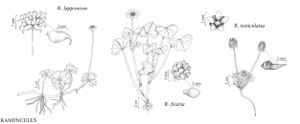Difference between revisions of "Ranunculus testiculatus"
Stirp. Austr. Fasc. 2: 97. 1763.
FNA>Volume Importer |
imported>Volume Importer |
||
| (7 intermediate revisions by 2 users not shown) | |||
| Line 8: | Line 8: | ||
}} | }} | ||
|special_status={{Treatment/ID/Special_status | |special_status={{Treatment/ID/Special_status | ||
| + | |code=W2 | ||
| + | |label= | ||
| + | }}{{Treatment/ID/Special_status | ||
|code=F | |code=F | ||
| − | |label= | + | |label=Illustrated |
| − | |||
| − | |||
| − | |||
}}{{Treatment/ID/Special_status | }}{{Treatment/ID/Special_status | ||
|code=I | |code=I | ||
| Line 19: | Line 19: | ||
|basionyms= | |basionyms= | ||
|synonyms={{Treatment/ID/Synonym | |synonyms={{Treatment/ID/Synonym | ||
| − | |name= | + | |name=Ceratocephalus orthoceras |
|authority=de Candolle | |authority=de Candolle | ||
| − | }}{{Treatment/ID/Synonym | + | |rank=species |
| − | |name= | + | }} {{Treatment/ID/Synonym |
| + | |name=Ceratocephalus testiculatus | ||
|authority=(Crantz) Roth | |authority=(Crantz) Roth | ||
| + | |rank=species | ||
}} | }} | ||
|hierarchy=Ranunculaceae;Ranunculus;Ranunculus subg. Ceratocephala;Ranunculus testiculatus | |hierarchy=Ranunculaceae;Ranunculus;Ranunculus subg. Ceratocephala;Ranunculus testiculatus | ||
| Line 32: | Line 34: | ||
}}<!-- | }}<!-- | ||
| − | --><span class="statement" id="st- | + | --><span class="statement" id="st-undefined" data-properties=""><b>Stems </b>erect or ascending, not rooting nodally, villous, not bulbous-based. <b>Tuberous</b> roots absent. <b>Basal</b> leaf blades broadly spatulate in outline, 1-2×-dissected, 0.9-3.8 × 0.5-1.5 cm, segments linear, margins entire, apex obtuse to acuminate. <b>Flowers</b>: receptacle glabrous; sepals spreading, 3-6 × 1-2 mm, villous; petals yellow, 3-5 × 1-3 mm. <b>Heads</b> of achenes cylindric, 9-16(-27) × 8-10 mm; achenes 1.6-2 × 1.8-2 mm, tomentose; beak persistent, lanceolate, 3.5-4.5 mm.</span><!-- |
-->{{Treatment/Body | -->{{Treatment/Body | ||
| Line 38: | Line 40: | ||
|habitat=Disturbed areas, especially in grassland | |habitat=Disturbed areas, especially in grassland | ||
|elevation=400-2500 m | |elevation=400-2500 m | ||
| − | |distribution=B.C.;Sask.;Ariz.;Calif.;Colo.;Idaho;Iowa;Kans.;Minn.;Mo.;Mont.;Nebr.;Nev.;N.Mex.;N.Dak.;Ohio;Oreg.;S.Dak.;Utah;Wash.;Wyo.;native to Eurasia | + | |distribution=B.C.;Sask.;Ariz.;Calif.;Colo.;Idaho;Iowa;Kans.;Minn.;Mo.;Mont.;Nebr.;Nev.;N.Mex.;N.Dak.;Ohio;Oreg.;S.Dak.;Utah;Wash.;Wyo.;native to Eurasia. |
| − | |discussion=<p>In North America, Ranunculus testiculatus seems to be expanding its range rapidly in arid and semiarid areas. A second species of this subgenus, R. falcatus Linnaeus [Ceratocephala falcata (Linnaeus) Persoon], has been reported from North America, but all reports seem to be based on misidentified material of R. testiculatus.</p> | + | |introduced=true |
| + | |discussion=<p>In North America, <i>Ranunculus testiculatus</i> seems to be expanding its range rapidly in arid and semiarid areas. A second species of this subgenus, R. falcatus Linnaeus [Ceratocephala falcata (Linnaeus) Persoon], has been reported from North America, but all reports seem to be based on misidentified material of <i>R. testiculatus</i>.</p> | ||
|tables= | |tables= | ||
|references= | |references= | ||
| Line 48: | Line 51: | ||
-->{{#Taxon: | -->{{#Taxon: | ||
name=Ranunculus testiculatus | name=Ranunculus testiculatus | ||
| − | |||
|authority=Crantz | |authority=Crantz | ||
|rank=species | |rank=species | ||
|parent rank=subgenus | |parent rank=subgenus | ||
| − | |synonyms= | + | |synonyms=Ceratocephalus orthoceras;Ceratocephalus testiculatus |
|basionyms= | |basionyms= | ||
|family=Ranunculaceae | |family=Ranunculaceae | ||
| Line 58: | Line 60: | ||
|habitat=Disturbed areas, especially in grassland | |habitat=Disturbed areas, especially in grassland | ||
|elevation=400-2500 m | |elevation=400-2500 m | ||
| − | |distribution=B.C.;Sask.;Ariz.;Calif.;Colo.;Idaho;Iowa;Kans.;Minn.;Mo.;Mont.;Nebr.;Nev.;N.Mex.;N.Dak.;Ohio;Oreg.;S.Dak.;Utah;Wash.;Wyo.;native to Eurasia | + | |distribution=B.C.;Sask.;Ariz.;Calif.;Colo.;Idaho;Iowa;Kans.;Minn.;Mo.;Mont.;Nebr.;Nev.;N.Mex.;N.Dak.;Ohio;Oreg.;S.Dak.;Utah;Wash.;Wyo.;native to Eurasia. |
|introduced=true | |introduced=true | ||
|reference=None | |reference=None | ||
|publication title=Stirp. Austr. Fasc. | |publication title=Stirp. Austr. Fasc. | ||
|publication year=1763 | |publication year=1763 | ||
| − | |special status= | + | |special status=W2;Illustrated;Introduced |
| − | |source xml=https:// | + | |source xml=https://bitbucket.org/aafc-mbb/fna-data-curation/src/2e0870ddd59836b60bcf96646a41e87ea5a5943a/coarse_grained_fna_xml/V3/V3_762.xml |
|genus=Ranunculus | |genus=Ranunculus | ||
|subgenus=Ranunculus subg. Ceratocephala | |subgenus=Ranunculus subg. Ceratocephala | ||
|species=Ranunculus testiculatus | |species=Ranunculus testiculatus | ||
| − | |||
| − | |||
| − | |||
| − | |||
| − | |||
| − | |||
| − | |||
| − | |||
| − | |||
| − | |||
| − | |||
| − | |||
| − | |||
| − | |||
| − | |||
| − | |||
| − | |||
| − | |||
| − | |||
| − | |||
| − | |||
| − | |||
| − | |||
| − | |||
| − | |||
| − | |||
| − | |||
}}<!-- | }}<!-- | ||
-->[[Category:Treatment]][[Category:Ranunculus subg. Ceratocephala]] | -->[[Category:Treatment]][[Category:Ranunculus subg. Ceratocephala]] | ||
Latest revision as of 22:51, 5 November 2020
Stems erect or ascending, not rooting nodally, villous, not bulbous-based. Tuberous roots absent. Basal leaf blades broadly spatulate in outline, 1-2×-dissected, 0.9-3.8 × 0.5-1.5 cm, segments linear, margins entire, apex obtuse to acuminate. Flowers: receptacle glabrous; sepals spreading, 3-6 × 1-2 mm, villous; petals yellow, 3-5 × 1-3 mm. Heads of achenes cylindric, 9-16(-27) × 8-10 mm; achenes 1.6-2 × 1.8-2 mm, tomentose; beak persistent, lanceolate, 3.5-4.5 mm.
Phenology: Flowering spring (Apr–May).
Habitat: Disturbed areas, especially in grassland
Elevation: 400-2500 m
Distribution

Introduced; B.C., Sask., Ariz., Calif., Colo., Idaho, Iowa, Kans., Minn., Mo., Mont., Nebr., Nev., N.Mex., N.Dak., Ohio, Oreg., S.Dak., Utah, Wash., Wyo., native to Eurasia.
Discussion
In North America, Ranunculus testiculatus seems to be expanding its range rapidly in arid and semiarid areas. A second species of this subgenus, R. falcatus Linnaeus [Ceratocephala falcata (Linnaeus) Persoon], has been reported from North America, but all reports seem to be based on misidentified material of R. testiculatus.
Selected References
None.
